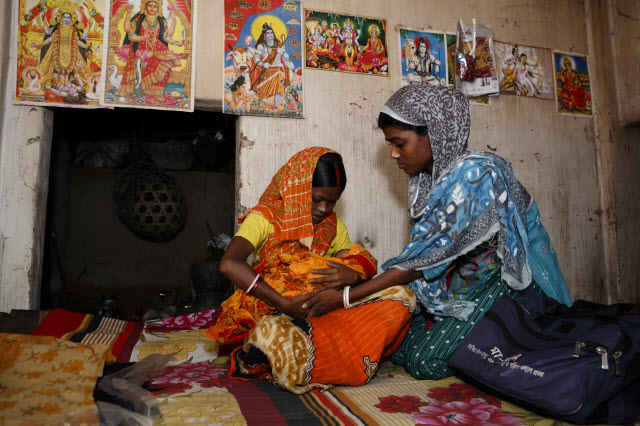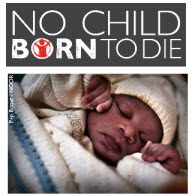What Will Be The Hardest Thing to See in Bangladesh?
 Saturday, September 15, 2012
Saturday, September 15, 2012 When Save the Children Canada first asked me to go with them to Bangladesh, I knew it would be simultaneously heart wrenching and incredible. I knew I would be seeing extreme poverty and hunger and sickness. I knew I would be learning about the amazing progress that organizations like Save the Children have made in helping women, families and communities to take charge of their own health and nutrition.
But there is an issue, one I'm well aware of, that had slipped my mind until I saw this picture.
Photo credit: Shafiqul Alam Kiron/Save the Children
The picture is from the The MaMoni project in Gowainghat Upazila, Sylhet in Bangladesh; an area I'll be visiting on my trip.
The MaMoni project aims to improve maternal and newborn health (MNH), and increase access to family planning (FP) services. The project supports and complements the Government of Bangladesh (GOB) Health, Nutrition and Population Sector Programme (HNPSP) strategy to reduce maternal and neonatal mortality in achieving the Millennium Development Goals (MDGs) in Bangladesh. Major focus is given to strengthening GOB service delivery systems to improve access to and quality of MNH and family planning services through capacity building, improved planning, and strengthening coordination between communities and healthcare service providers. MaMoni will also ensure easy access to existing public healthcare facilities and promote the benefits of healthy healthcare practices and also family planning services. The project is implemented in 15 upazilas (sub-districts) of Sylhet and Habiganj districts in northeast Bangladesh. The total population of the project area is 3.5 million.
At first glance one might think the picture is of an older sibling being taught how to care for a baby brother or sister so that she can help out at home. But it's not. The red Sindoor applied to the part of her hair signifies that she is a married woman. That, plus several other photos of this same girl made it clear that she was not the baby's sibling or caretaker. She is the baby's mother. To be fair, I don't know how old this girl is. The information provided on this photo and the other pictures of her didn't include her age. But she does look young and seeing that picture, which didn't look that different from my daughter holding one of her dolls, was enough to make me look into the issue of child marriage in Bangladesh.
According to the International Center for Research on Women, 66.2 percent of girls in Bangladesh were married before their 18th birthday in 2010, despite the fact that marriage is illegal for people under the age of 18. Bangladesh is ranked fourth in the world in terms of the prevalence of child marriages, behind Niger, Chad and Mali. That is a slight improvement over 2005, when the 68.7 percent of girls in Bangladesh were married before the age of 18 and that is the only solace that I can take in this situation. In Mali, on the other hand, the numbers are getting higher instead of lower.
I don't know how old the girl in the picture I shared above is, but I have accessed some other stories of girls in Bangladesh via Save the Children. This story was written based on an interview conducted by Save the Children in January 2012.
Sharmin Begum, 15, lives with her husband Babul Sheik, in Baroikhali village in south-western Bangladesh.
Sharmin has had a disability since she was very young, after suffering with epilepsy followed by problems with her appendix. She was married off when she was only 12. When she was 14, she gave birth to a boy, Ibrahim, by caesarean section.
Whilst she was pregnant, Sharmin didn't eat nutritious food and only ever ate a maximum of two meals a day. She was weak and ill frequently but was really happy to have a son.
"I took care of him. I loved him. I planned to educate him and gave him everything but I lost him."
Sharmin could only afford to give her son breast milk and after six months, when that was no longer sufficient for him, she would have to leave him hungry. Sometimes her parents would give him fruit but not regularly.
Ibrahim started suffering with a fever. In desperation, Sharmin and Babul took him to the pharmacy and brought him medicine. The pharmacist suggested she take him to the hospital but Sharmin has never had any money. She couldn't afford the treatment so she brought him home. He survived for four or five days and then died at home. She hasn't recovered from the pain and shock of her loss and misses him all of the time.
When Ibrahim died, Sharmin felt like as if she had lost her future. "I had started to make plans for him. I was living for him."
Sharmin couldn't afford good food for her son and she thinks that's why he died. She blames herself.
"If I could provide good nutritious food for him then he would still be alive... It's not fair, rich people can afford nutritious food for their children but poor people can't."
Sharmin cooks only once a day. They have one meal for lunch at 1pm and then leftovers for breakfast at 8am the next day. She eats rice with lentils, mashed potato and green chilies. "I can't sleep because I'm so hungry and feel so weak."
Sharmin would love another child but knows it is too dangerous for her to give birth without a caesarean. For a caesarean she would need money that she hasn't got.
Sharmin's story is just one of many young girls who are forced to marry because their families can't afford to feed them. They, in turn, get pregnant and have babies that they are unable to feed, which puts the girls (girls under 15 are more than times as likely to die in childbirth than women in their twenties) and their babies at risk. It is a cycle that repeats itself over and over again.
While I'm in Bangladesh, I look forward to seeing what is being done to improve the health and nutrition of women, children and communities. But I'll also be watching closely for initiatives designed to protect these girls, allow them to be educated, and keep them from being forced into marriages when their bodies are not even finished developing.
During the last week of September, I'll be traveling to Bangladesh with Save the Children Canada. You can follow my trip, both here on my blog as well as on twitter (@phdinparenting) and my facebook page. You can also help by asking Prime Minister Stephen Harper to sign a global pledge to end preventable child death by signing the No Child Born to Die petition or by making a donation to Save the Children.
 Gender Issues,
Gender Issues,  Nutrition and tagged with
Nutrition and tagged with  Bangladesh,
Bangladesh,  Save the Children,
Save the Children,  feminism,
feminism,  girls,
girls,  marriage,
marriage,  women
women 



















Reader Comments (14)
Annie, thanks for writing about this. I heard Foreign Affairs Minister John Baird in a radio clip speaking out against child brides. Perhaps that signals a change in policy is coming. Let's hope so. I will follow-up and learn more.
This was an interesting -and heartbreaking- read, Annie. Peter is considering a post in Dhaka, Bangladesh, for fall 2013. I'll be following your posts closely.
Annie, I canot imagine what you will learn during your trip, but (selfishly) I hope that there are wonderful innovations afoot, mainly in the areas of child hunger and poverty. I'm glad you have the chance to go and share, and will be following along!
Unfortunately, I'm sure there will be many difficult things you will see on your trip, as you say. I can also imagine that you may run into some challenging political territory writing about the dynamics of a third world country as a (first-time?) white (I'm assuming that this is how you identify. This may be presumptuous of me, and I will humbly stand corrected if I am wrong), likely more economically privileged visitor. I wonder if you've checked out AWID's work? I think they are a pretty solid, and may provide some useful analysis by women and feminists from the global South...http://www.awid.org. Best of luck...
Amazing, heartbreaking, thought provoking, thanks for sharing.
Also, you might find this interesting, too...http://www.bridge.ids.ac.uk/go/bridge-publications/cutting-edge-packs/gender-and-cultural-change/
Thanks el. I appreciate the resources. I am aware enough of my privilege to know that I have lots of reading, learning, and listening to do and that no matter how much reading, learning and listening I do, it will still never be enough.
Gosh. Hard to read. This will be a wonderful experience, but really tough sometimes. But you're shedding light, which is why they want you. Thanks for that.
Be sure to let me know if you have any questions, Amy. I'll do what I can to find answers while I'm there.
I have a feeling this trip is going to forever change you Annie and I am looking forward to following along on your {heart-wrenching} journey.
In fact, breast milk alone would be sufficient for the baby also after 6 months if the mother wasn't malnourished. Breast milk protects the baby against infections, so we should feed the mothers first of all. I'm also afraid that the medicine to stop fever could have a negative instead of a positive effect. Free access to a doctor who could diagnose an ill child is crucial.
This really made me re-think the clothing labels on my clothes, esp. H&M. It's like putting faces to the young girls who make my cheap clothes.
I was privileged to visit Bangladesh in 1996, as part of a Naval detachment. I was 21 - it utterly blew my mind. So much beauty, so much pain! One little boy in a group of children begging wrapped his arms around my leg and would not let go. One of my colleagues had to pry him away from me. I would have gladly taken him home but of course it's never that simple. I sobbed for the rest of that day...
It's just really good to see that Bangladesh is not forgotten, that organizations like Save the Children are still working to do just that.
[...] I left for Bangladesh, I wrote about child marriage, noting that it would probably be the most difficult thing to see. Seeing so many young mothers was [...]